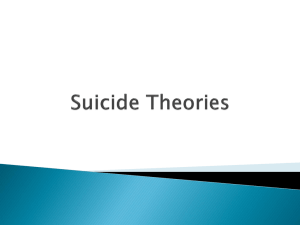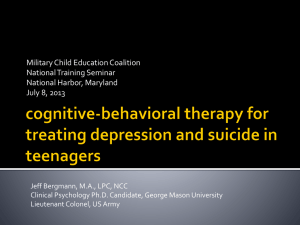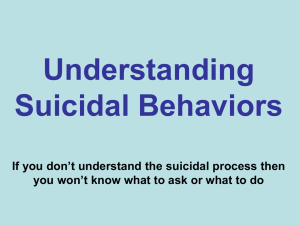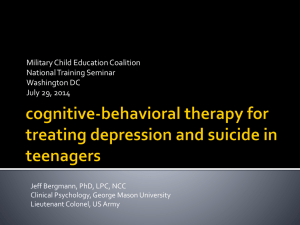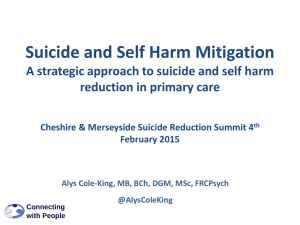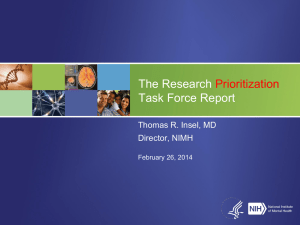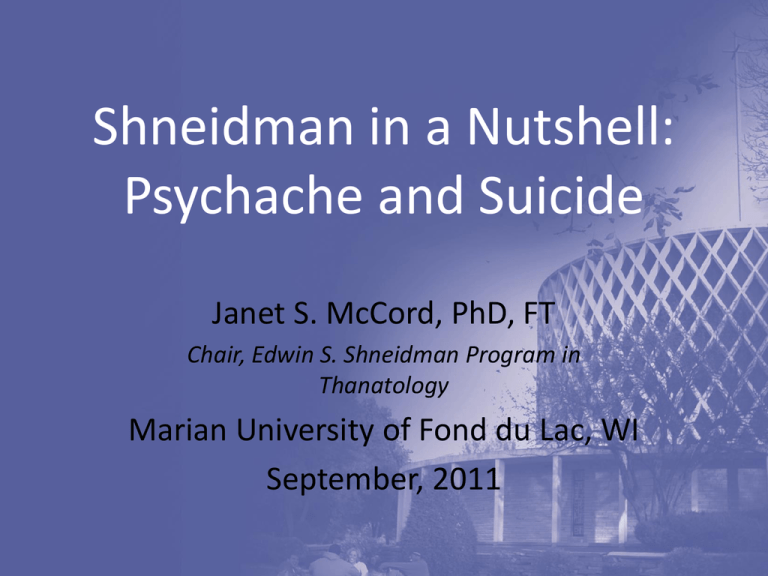
Shneidman in a Nutshell:
Psychache and Suicide
Janet S. McCord, PhD, FT
Chair, Edwin S. Shneidman Program in
Thanatology
Marian University of Fond du Lac, WI
September, 2011
Learning Objectives
• At the end of this presentation, the participant
will be able to discuss:
– The CONTEXT: Summarize Shneidman’s
progression of thought over time.
– The CONTENT: Define psychache
– The APPLICATION: Discuss ways of using
psychache in intervention and prevention
strategies.
The Context:
Shneidman’s Progression of
Thought Over Time
Ancestry and Birth (1918)
Young Adulthood
• 1934 – 1940: UCLA (undergraduate and Master’s
in psychology)
• 1949 – 1942: worked as civil servant
• 1942 – 1946: Captain in Army Air Force
• 1946 – 1948: Doctoral program in Clinical
Psychology at USC
– Schizophrenia and the MAPS Test
• 1948: Full time for Veterans Administration
• 1950: Meets Henry Murray
• 1961: Harvard University
– U.S. Public Health Services special research fellow
Shneidman and Suicide
• 1949: Discovers suicide notes in LA County
Coroner’s vault
• 1955: 3-year research grant from NIMH
• 1958: Los Angeles Suicide Prevention Center
created
– Shneidman, Norman Farberow, Robert Litman
– 1958-1969: 7-year project grant from NIMH
National Suicide Prevention
• 1966 – 1969: NIMH and National Suicide
Prevention Program
– Number of SPC’s nationally increased from 3 to 200 in
two years
• 1968 – 1971: Co-edited the Bulletin of
Suicidology
• 1968: Founded the American Association of
Suicidology
• 1970: UCLA Medical School Department of
Psychiatry
– Shifted focus to thanatology and terminally ill
– Studied a special “kind” of suicidal person
The Content:
Define psychache
Henry Murray’s
Explorations in Personality
1938
• Function of personality:
– Reduce inner tension
– Self-expression
– Reduction of conflicts (by scheduling and social
conformity)
• Reduction of inner tension
– Satisfaction of inner demands or “needs”
Definition of Suicide (1977)
Shneidman’s Intentionally Non-traditional Approach
• Not lean on “suicidological giants” – Freud,
Durkheim
• Eschew demographics
• Ignore all psychiatric categories
• Assume that 100% of suicidal persons are
perturbed
• Approach from non-suicidal theoretical
directions
1) Situational
1. Common stimulus: unbearable psychological pain
2. Common stressor: frustrated needs
2) Conative (purpose, goal)
3. Common purpose: to seek a solution
4. Common goal: cessation of consciousness
3) Affective
5. Common emotion: hopelessness-helplessness
6. Common internal attitude: ambivalence
4) Cognitive
7. Common cognitive state: constriction (tunneling)
5) Relational
8. Common interpersonal act: communication of intention
9. Common action: escape
6) Serial
10. Common consistency: lifelong coping patterns
Perturbation
• Not to be confused with psychache
• State of being emotionally upset, disturbed,
disquiet
– Jobes: agitation
• Both cognitive constriction and penchant for
self-harm
• Impulse to do something to alter current
situation
• Psychological energy driving the suicidal
action
Shneidman’s Cubic Model of Suicide
(1987)
Low to High
Press
(Stress)
Completed
Suicide
1
5
5
High to Low
Perturbation/
Agitation
4
3
2
1
1
2
3
4
5
Low to High
Psychache
(Pain)
Murray Need Form
•
•
•
•
•
•
•
•
•
•
Abasement
Achievement
Affiliation
Aggression
Autonomy
Counteraction
Defendance
Deference
Dominance
Exhibition
•
•
•
•
•
•
•
•
•
•
Harmavoidance
Inviolacy
Nurturance
Order
Play
Rejection
Sentience
Shame-avoidance
Succorance
Understanding
Murray Need Form
(Shneidman, 1996)
• Rank order
• Sum of 100
Two Kinds of Needs
• Modal Needs
– Weighted needs that characterize the personality
• Vital Needs
– Needs an individual focuses on under stress,
suffering, heightened inner tension, and in mental
pain
Modal
Needs
Vital
Needs
Five “Clusters” of Needs
• Thwarted love, acceptance, belonging
– succorance, affiliation
• Fractured control, predictability, arrangement
– achievement, autonomy, order, understanding
• Assaulted self-image and avoidance of shame
– affiliation, defendance, shame-avoidance
• Ruptured key relationships and grief
– affiliation, nurturance
• Excessive anger, rage, hostility
– dominance, aggression, counteraction
In a Nutshell
• Suicide stems from psychological pain
• Psychological pain comes from frustrated
psychological needs peculiar to each person
• Threshold for pain is unique to each person
– Can be related to early childhood assaults and
losses
– “I tend to believe that, at rock bottom, the pains
that drive suicide relate primarily not to the
precipitous absence of . . . happiness in
adulthood, but to the haunting losses of
childhood’s special joys.” (Shneidman, 1996, 164)
Psychache as Cause of Suicide
“The implications of this psychological view
are quite extensive. For one thing, it means
that our best route to understanding suicide is
not through the study of the structure of the
brain, nor the study of social statistics, nor the
study of mental diseases, but directly through
the study of human emotions described in
plain English, in the words of the suicidal
person.” (Shneidman, 1996, 6)
Shneidman’s Two Questions
Where do you hurt?
How can I help?
How willing am I to be
inconvenienced by another
person’s answers to the two
most important questions?
(with gratitude to Harold Ivan Smith)
The Application:
Discuss ways of using psychache in
intervention and prevention
Aeschi Working Group
• Konrad Michel, M.D.
• Antoon A. Leenaars,
Ph.D.
• David A. Jobes, Ph.D.
• John T. Maltsberger,
M.D.
• Israel Orbach, Ph.D.
• Ladislav Valach, Ph.D.
• Richard A. Young, Ph.D.
• Michael Bostwick, M.D.
• February 2000: first
Aeschi Working Group
meeting
Historical “Medical Model” Approach
1. Suicide attempt and/or expression of suicidality
with plan
a) Patient hospitalized (frequently)
b) Therapist and patient (normally) sit across from one
another.
c) Therapist interviews patient to assess risk of further
suicidal actions through looking for clinical risk
factors/psychiatric disorder(s): depression, lack of
sleep, poor appetitie, anhedonia, and suicidality.
• Interview may last 30 minutes
Aeschi Working Group http://www.aeschiconference.unibe.ch/usual_clinical_practice.htm
21st Century Approach
• Psychotropic medication and outpatient
treatment
– Cheap
– Medication compliance not good
– When hospitalization is allowed, it is usually
inadequate
– Poor outcomes can lead to death and lawsuits
(even against outpatient mental health providers)
– Many clinicians refuse to treat suicidal patients
Collaborative Assessment and
Management of Suicidality (CAMS)
• David Jobes, PhD, Catholic University of
America
• A philosophy and clinical approach
– Suicide viewed as a coping mechanism
• Alternative means of coping can be learned
– Clinical assessment and treatment planning
– Management of suicidal risk with suicidal
outpatients
– Strong therapeutic alliance is required for success
Three Phases
1. Initial “Index” Assessment/treatment planning
2. Clinical tracking
3. Clinical outcomes
• Core multipurpose tool: SSF
– Serves as a clinical roadmap throughout clinical
process all the way to outcomes
• Engages patient in assessment and treatment
planning
• CENTRAL: Strong therapeutic relationship
•
•
•
•
with the suicidal person
Suicidal person is engaged in the assessment of
their own suicidal risk
Suicidal person is engaged in co-authoring the
treatment plan
Suicidal person takes responsibility for their own
safety and stability
Goal:
–
–
–
–
Reduce or eliminate hospitalization
Reduce use of suicide as a coping mechanism
Improve problem-solving skills
Enhance reasons for living
“When coping and problem solving
improves, the option of suicide can
be made systematically obsolete
through thoughtful and systematic
clinical care that is central to the
CAMS approach.”
(Jobes, Managing Suicidal Risk: A Collaborative Approach, 2006, 6-7)
David Jobes’ “Truisms”
• Most suicidal people do not want an end to their
biological existence;
– rather, they want an end to their psychological pain
and suffering.
• Most suicidal people tell others (including mental
health professionals) that they are thinking about
suicide as a compelling option for coping with
their pain.
• Most suicidal people have psychological
problems, social problems, and poor methods for
coping with pain –
– all things that mental health professionals are usually
well trained to tackle.
(Jobes, Managing Suicidal Risk: A Collaborative Approach, 2006, 7)
“. . . I am passionately interested in providing a
reasonable response to ending psychological
pain without costing a patient his or her life. I
have heard what my suicidal patients have said
about their pain and suffering and I am
dedicated to responding effectively to that pain
and suffering. I am especially resolved to use my
training and skills to fundamentally address
psychological and social problems, creating whole
new and better ways of coping with seemingly
unbearable pain. . . . Helping our patients find a
way to choose life is the point of all our efforts in
this most crucial of all clinical endeavors.”
(Jobes, Managing Suicidal Risk: A Collaborative Approach, 2006, 7)
Suicide Status Form (SSF© Jobes, 2000)
• Core multi-purpose tool used within Jobes’
Collaborative Assessment and Management of
Suicidality approach
• Used for:
– Core assessment
– Treatment planning
– Tracking
– Outcome mapping
CAMS Research
• Suicidal Air Force personnel (n = 55) at two Air Force
Life Skills Clinics in Colorado (Jobes et. al., 2005)
• One-third of those who sought mental health care had
suicidal ideation
• Trained clinicians in CAMS
• Retrospective study comparing group (n=25) treated
with CAMS with group (n=30) who received “treatment
as usual”
• Suicidal patients in CAMS group
– CAMS group needed fewer sessions (10 to 12 against more
than 20 in non-CAMS group)
– TAU group had 25 ER visits compared with 5 in CAMS in 6
months following index MHC
CAMS in Other Settings
• Hotlines and Crisis Centers
• Outpatient clinics
• Community mental health centers
– Requires more time, patience and perseverance when
used with the psychotic and delusional
• Private practice
• Forensic settings (use currently limited)
• Emergency departments
– Research on whether or not CAMS use will improve
attendance at NDAs
• Inpatient settings
– Mayo Clinic
– Switzerland
Psychache in Other Settings
• Psycho-education
– Group settings
– Individual counseling
• Clinical grief counseling
– Use of SSF may be appropriate if survivor is exhibiting
suicidality
• Community education
– Stigma associated with
• Incomplete understanding of the dynamics of suicidality
• Fear
• Centuries of religious/ social/ legal discrimination
References
• Shneidman, Edwin S.
– The Suicidal Mind. Oxford University Press, 1998
– Suicide as Psychache: A Clinical Approach to
Suicidal Behavior. Rowman & Littlefield Inc., 1995
– A Life in Death. Self published. 1989
– Definition of Suicide. Jason Aronson, 1977.
• Jobes, David A.
– Managing Suicidal Risk: A Collaborative Approach.
The Guilford Press, 2006

